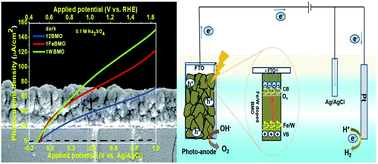当前位置:
X-MOL 学术
›
Sustain. Energy Fuels
›
论文详情
Our official English website, www.x-mol.net, welcomes your
feedback! (Note: you will need to create a separate account there.)
Fe and W doped Bi2MoO6 nanoflakes: a promising material for efficient solar water splitting
Sustainable Energy & Fuels ( IF 5.0 ) Pub Date : 2019/12/30 , DOI: 10.1039/c9se00796b Mohua Chakraborty 1, 2, 3, 4 , Sourav Ghosh 1, 2, 3, 4 , Venkataramanan Mahalingam 1, 2, 3, 4
Sustainable Energy & Fuels ( IF 5.0 ) Pub Date : 2019/12/30 , DOI: 10.1039/c9se00796b Mohua Chakraborty 1, 2, 3, 4 , Sourav Ghosh 1, 2, 3, 4 , Venkataramanan Mahalingam 1, 2, 3, 4
Affiliation

|
Recently, Bi2MoO6 (BMO) has been extensively investigated due to its noticeable photoelectrochemical water oxidation properties. However, the poor chemical stability and high photo-corrosion have suppressed its potential application and efficiency of solar energy conversion. In this work, BMO films have been successfully grown via a solvothermal method with different durations and the optimized synthesis conditions have been further retained to prepare Fe and W doped BMO photoanodes. Photocurrent densities as high as ≈1.81, 0.89, and 0.43 mA cm−2 at 1.23 V vs. RHE are obtained for the optimum 1% W doped, 1% Fe doped and pristine BMO, respectively, under light illumination (AM 1.5, 100 mW cm−2) in 0.1 M Na2SO4 electrolyte in the presence of 0.05 M Na2SO3 hole scavenger. A high photocurrent density of about 107.84 μA cm−2 at 1.23 V vs. RHE is obtained for the optimized W doped photoanode in the absence of 0.05 M Na2SO3 electrolyte, which is 2.18 and 1.22 times enhanced compared to those of the optimum undoped BMO and Fe doped BMO thin film photoanodes, respectively. The dopant contributed to the oxygen vacancy and film conductivity and helped both in terms of stability and PEC activity. W and Fe doped BMO exhibit considerable stability under water and sulfite oxidation conditions compared to undoped BMO in the absence of any oxygen evolution co-catalysts.
中文翻译:

Fe和W掺杂的Bi2MoO6纳米薄片:有效分解太阳能的有前途的材料
近来,Bi 2 MoO 6(BMO)由于其显着的光电化学水氧化特性而被广泛研究。然而,不良的化学稳定性和高的光腐蚀抑制了其潜在的应用和太阳能转换的效率。在这项工作中,BMO膜已通过溶剂热方法成功地生长了不同的持续时间,并且还保留了优化的合成条件以制备Fe和W掺杂的BMO光阳极。光电流密度高达≈1.81,0.89,和0.43毫安厘米-2在的1.23V相对于RHE针对最佳1%的W掺杂得到的,1%的Fe掺杂和原始BMO,分别在光照射(AM 1.5,100毫米厘米-2)在0.05 M Na 2 SO 3空穴清除剂的存在下,在0.1 M Na 2 SO 4电解质中。在不存在0.05 M Na 2 SO 3的情况下,对于优化的W掺杂光阳极,在1.23 V vs. RHE下可获得约107.84μAcm -2的高光电流密度与最佳的无掺杂BMO和掺Fe的BMO薄膜光电阳极相比,电解质分别提高了2.18和1.22倍。掺杂物有助于氧空位和薄膜电导率,并在稳定性和PEC活性方面均有所帮助。在没有氧气释放助催化剂的情况下,与未掺杂的BMO相比,掺有W和Fe的BMO在水和亚硫酸盐氧化条件下表现出相当高的稳定性。
更新日期:2020-03-03
中文翻译:

Fe和W掺杂的Bi2MoO6纳米薄片:有效分解太阳能的有前途的材料
近来,Bi 2 MoO 6(BMO)由于其显着的光电化学水氧化特性而被广泛研究。然而,不良的化学稳定性和高的光腐蚀抑制了其潜在的应用和太阳能转换的效率。在这项工作中,BMO膜已通过溶剂热方法成功地生长了不同的持续时间,并且还保留了优化的合成条件以制备Fe和W掺杂的BMO光阳极。光电流密度高达≈1.81,0.89,和0.43毫安厘米-2在的1.23V相对于RHE针对最佳1%的W掺杂得到的,1%的Fe掺杂和原始BMO,分别在光照射(AM 1.5,100毫米厘米-2)在0.05 M Na 2 SO 3空穴清除剂的存在下,在0.1 M Na 2 SO 4电解质中。在不存在0.05 M Na 2 SO 3的情况下,对于优化的W掺杂光阳极,在1.23 V vs. RHE下可获得约107.84μAcm -2的高光电流密度与最佳的无掺杂BMO和掺Fe的BMO薄膜光电阳极相比,电解质分别提高了2.18和1.22倍。掺杂物有助于氧空位和薄膜电导率,并在稳定性和PEC活性方面均有所帮助。在没有氧气释放助催化剂的情况下,与未掺杂的BMO相比,掺有W和Fe的BMO在水和亚硫酸盐氧化条件下表现出相当高的稳定性。











































 京公网安备 11010802027423号
京公网安备 11010802027423号